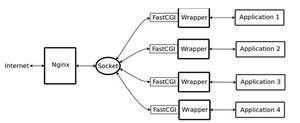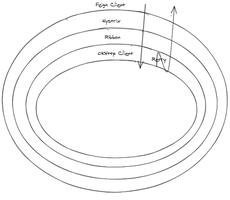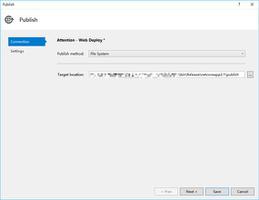Hystrix线程池配置

本文介绍Hystrix线程池的工作原理和参数配置,指出存在的问题并提供规避方案,阅读本文需要对Hystrix有一定的了解。
文本讨论的内容,基于hystrix 1.5.18:
<dependency> <groupId>com.netflix.hystrix</groupId>
<artifactId>hystrix-core</artifactId>
<version>1.5.18</version>
</dependency>
线程池和Hystrix Command之间的关系
当hystrix command的隔离策略配置为线程,也就是execution.isolation.strategy设置为THREAD时,command中的代码会放到线程池里执行,跟发起command调用的线程隔离开。摘要官方wiki如下:
execution.isolation.strategy
This property indicates which isolation strategy HystrixCommand.run() executes with, one of the following two choices:
THREAD — it executes on a separate thread and concurrent requests are limited by the number of threads in the thread-pool SEMAPHORE — it executes on the calling thread and concurrent requests are limited by the semaphore count
一个线上的服务,往往会有很多hystrix command分别用来管理不同的外部依赖。 但会有几个hystrix线程池存在呢,这些command跟线程池的对应关系又是怎样的呢,是一对一吗?
答案是不一定,command跟线程池可以做到一对一,但通常不是,受到HystrixThreadPoolKey和HystrixCommandGroupKey这两项配置的影响。
优先采用HystrixThreadPoolKey来标识线程池,如果没有配置HystrixThreadPoolKey那么就使用HystrixCommandGroupKey来标识。command跟线程池的对应关系,就看HystrixCommandKey、HystrixThreadPoolKey、HystrixCommandGroupKey这三个参数的配置。
获取线程池标识的代码如下,可以看到跟我的描述是一致的:
/* * ThreadPoolKey
*
* This defines which thread-pool this command should run on.
*
* It uses the HystrixThreadPoolKey if provided, then defaults to use HystrixCommandGroup.
*
* It can then be overridden by a property if defined so it can be changed at runtime.
*/
private static HystrixThreadPoolKey initThreadPoolKey(HystrixThreadPoolKey threadPoolKey, HystrixCommandGroupKey groupKey, String threadPoolKeyOverride) {
if (threadPoolKeyOverride == null) {
// we don"t have a property overriding the value so use either HystrixThreadPoolKey or HystrixCommandGroup
if (threadPoolKey == null) {
/* use HystrixCommandGroup if HystrixThreadPoolKey is null */
return HystrixThreadPoolKey.Factory.asKey(groupKey.name());
} else {
return threadPoolKey;
}
} else {
// we have a property defining the thread-pool so use it instead
return HystrixThreadPoolKey.Factory.asKey(threadPoolKeyOverride);
}
}
Hystrix会保证同一个线程池标识只会创建一个线程池:
/* * Use the String from HystrixThreadPoolKey.name() instead of the HystrixThreadPoolKey instance as it"s just an interface and we can"t ensure the object
* we receive implements hashcode/equals correctly and do not want the default hashcode/equals which would create a new threadpool for every object we get even if the name is the same
*/
/* package */final static ConcurrentHashMap<String, HystrixThreadPool> threadPools = new ConcurrentHashMap<String, HystrixThreadPool>();
/**
* Get the {@link HystrixThreadPool} instance for a given {@link HystrixThreadPoolKey}.
* <p>
* This is thread-safe and ensures only 1 {@link HystrixThreadPool} per {@link HystrixThreadPoolKey}.
*
* @return {@link HystrixThreadPool} instance
*/
/* package */static HystrixThreadPool getInstance(HystrixThreadPoolKey threadPoolKey, HystrixThreadPoolProperties.Setter propertiesBuilder) {
// get the key to use instead of using the object itself so that if people forget to implement equals/hashcode things will still work
String key = threadPoolKey.name();
// this should find it for all but the first time
HystrixThreadPool previouslyCached = threadPools.get(key);
if (previouslyCached != null) {
return previouslyCached;
}
// if we get here this is the first time so we need to initialize
synchronized (HystrixThreadPool.class) {
if (!threadPools.containsKey(key)) {
threadPools.put(key, new HystrixThreadPoolDefault(threadPoolKey, propertiesBuilder));
}
}
return threadPools.get(key);
}
Hystrix线程池参数一览
- coreSize 核心线程数量
- maximumSize 最大线程数量
- allowMaximumSizeToDivergeFromCoreSize 允许maximumSize大于coreSize,只有配了这个值coreSize才有意义
- keepAliveTimeMinutes 超过这个时间多于coreSize数量的线程会被回收,只有maximumsize大于coreSize,这个值才有意义
- maxQueueSize 任务队列的最大大小,当线程池的线程线程都在工作,也不能创建新的线程的时候,新的任务会进到队列里等待
- queueSizeRejectionThreshold 任务队列中存储的任务数量超过这个值,线程池拒绝新的任务。这跟maxQueueSize本来是一回事,只是受限于hystrix的实现方式maxQueueSize不能动态配置,所以有了这个配置。
根据给定的线程池参数猜测线程池表现
可以看到hystrix的线程池参数跟JDK线程池ThreadPoolExecutor参数很像但又不一样,即便是完整地看了文档,仍然让人迷惑。不过无妨,先来猜猜几种配置下的表现。
coreSize = 2; maxQueueSize = 10线程池中常驻2个线程。新任务提交到线程池,有空闲线程则直接执行,否则入队等候。等待队列中的任务数=10时,拒绝接受新任务。
coreSize = 2; maximumSize = 5; maxQueueSize = -1线程池中常驻2个线程。新任务提交到线程池,有空闲线程则直接执行,没有空闲线程时,如果当前线程数小于5则创建1个新的线程用来执行任务,否则拒绝任务。
coreSize = 2; maximumSize = 5; maxQueueSize = 10这种配置下从官方文档中已经看不出来实际表现会是怎样的。猜测有如下两种可能:
可能一。线程池中常驻2个线程。新任务提交到线程池,2个线程中有空闲则直接执行,否则入队等候。当2个线程都在工作且等待队列中的任务数=10时,开始为新任务创建线程,直到线程数量为5,此时开始拒绝新任务。这样的话,对资源敏感型的任务比较友好,这也是JDK线程池ThreadPoolExecutor的行为。
可能二。线程池中常驻2个线程。新任务提交到线程池,有空闲线程则直接执行,没有空闲线程时,如果当前线程数小于5则创建1个新的线程用来执行任务。当线程数量达到5个且都在工作时,任务入队等候。等待队列中的任务数=10时,拒绝接受新任务。这样的话,对延迟敏感型的任务比较友好。
两种情况都有可能,从文档中无法确定究竟如何。
并发情况下Hystrix线程池的真正表现
本节中,通过测试来看看线程池的行为究竟会怎样。
还是这个配置:
coreSize = 2; maximumSize = 5; maxQueueSize = 10我们通过不断提交任务到hystrix线程池,并且在任务的执行代码中使用CountDownLatch占住线程来模拟测试,代码如下:
public class HystrixThreadPoolTest { public static void main(String[] args) throws InterruptedException {
final int coreSize = 2, maximumSize = 5, maxQueueSize = 10;
final String commandName = "TestThreadPoolCommand";
final HystrixCommand.Setter commandConfig = HystrixCommand.Setter
.withGroupKey(HystrixCommandGroupKey.Factory.asKey(commandName))
.andCommandKey(HystrixCommandKey.Factory.asKey(commandName))
.andCommandPropertiesDefaults(
HystrixCommandProperties.Setter()
.withExecutionTimeoutEnabled(false))
.andThreadPoolPropertiesDefaults(
HystrixThreadPoolProperties.Setter()
.withCoreSize(coreSize)
.withMaximumSize(maximumSize)
.withAllowMaximumSizeToDivergeFromCoreSize(true)
.withMaxQueueSize(maxQueueSize)
.withQueueSizeRejectionThreshold(maxQueueSize));
// Run command once, so we can get metrics.
HystrixCommand<Void> command = new HystrixCommand<Void>(commandConfig) {
@Override protected Void run() throws Exception {
return null;
}
};
command.execute();
Thread.sleep(100);
final CountDownLatch stopLatch = new CountDownLatch(1);
List<Thread> threads = new ArrayList<Thread>();
for (int i = 0; i < coreSize + maximumSize + maxQueueSize; i++) {
final int fi = i + 1;
Thread thread = new Thread(new Runnable() {
public void run() {
try {
HystrixCommand<Void> command = new HystrixCommand<Void>(commandConfig) {
@Override protected Void run() throws Exception {
stopLatch.await();
return null;
}
};
command.execute();
} catch (HystrixRuntimeException e) {
System.out.println("Started Jobs: " + fi);
System.out.println("Job:" + fi + " got rejected.");
printThreadPoolStatus();
System.out.println();
}
}
});
threads.add(thread);
thread.start();
Thread.sleep(200);
if(fi == coreSize || fi == coreSize + maximumSize || fi == coreSize + maxQueueSize ) {
System.out.println("Started Jobs: " + fi);
printThreadPoolStatus();
System.out.println();
}
}
stopLatch.countDown();
for (Thread thread : threads) {
thread.join();
}
}
static void printThreadPoolStatus() {
for (HystrixThreadPoolMetrics threadPoolMetrics : HystrixThreadPoolMetrics.getInstances()) {
String name = threadPoolMetrics.getThreadPoolKey().name();
Number poolSize = threadPoolMetrics.getCurrentPoolSize();
Number queueSize = threadPoolMetrics.getCurrentQueueSize();
System.out.println("ThreadPoolKey: " + name + ", PoolSize: " + poolSize + ", QueueSize: " + queueSize);
}
}
}
执行代码得到如下输出:
// 任务数 = coreSize。此时coreSize个线程在工作Started Jobs: 2
ThreadPoolKey: TestThreadPoolCommand, PoolSize: 2, QueueSize: 0
// 任务数 > coreSize。此时仍然只有coreSize个线程,多于coreSize的任务进入等候队列,没有创建新的线程
Started Jobs: 7
ThreadPoolKey: TestThreadPoolCommand, PoolSize: 2, QueueSize: 5
// 任务数 = coreSize + maxQueueSize。此时仍然只有coreSize个线程,多于coreSize的任务进入等候队列,没有创建新的线程
Started Jobs: 12
ThreadPoolKey: TestThreadPoolCommand, PoolSize: 2, QueueSize: 10
// 任务数 > coreSize + maxQueueSize。此时仍然只有coreSize个线程,等候队列已满,新增任务被拒绝
Started Jobs: 13
Job:13 got rejected.
ThreadPoolKey: TestThreadPoolCommand, PoolSize: 2, QueueSize: 10
Started Jobs: 14
Job:14 got rejected.
ThreadPoolKey: TestThreadPoolCommand, PoolSize: 2, QueueSize: 10
Started Jobs: 15
Job:15 got rejected.
ThreadPoolKey: TestThreadPoolCommand, PoolSize: 2, QueueSize: 10
Started Jobs: 16
Job:16 got rejected.
ThreadPoolKey: TestThreadPoolCommand, PoolSize: 2, QueueSize: 10
Started Jobs: 17
Job:17 got rejected.
ThreadPoolKey: TestThreadPoolCommand, PoolSize: 2, QueueSize: 10
完整的测试代码,参见这里
可以看到Hystrix线程池的实际表现,跟之前的两种猜测都不同,跟JDK线程池的表现不同,跟另一种合理猜测也不通。当maxSize > coreSize && maxQueueSize != -1的时候,maxSize这个参数根本就不起作用,线程数量永远不会超过coreSize,对于的任务入队等候,队列满了,就直接拒绝新任务。
不得不说,这是一种让人疑惑的,非常危险的,容易配置错误的线程池表现。
JDK线程池ThreadPoolExecutor
继续分析Hystrix线程池的原理之前,先来复习一下JDK中的线程池。
只说跟本文讨论的内容相关的参数:
- corePoolSize核心线程数,maximumPoolSize最大线程数。这个两个参数跟hystrix线程池的coreSize和maximumSize含义是一致的。
- workQueue任务等候队列。跟hystrix不同,jdk线程池的等候队列不是指定大小,而是需要使用方提供一个BlockingQueue。
- handler当线程池无法接受任务时的处理器。hystrix是直接拒绝,jdk线程池可以定制。
可以看到,jdk的线程池使用起来更加灵活。配置参数的含义也十分清晰,没有hystrx线程池里面allowMaximumSizeToDivergeFromCoreSize、queueSizeRejectionThreshold这种奇奇怪怪让人疑惑的参数。
关于jdk线程池的参数配置,参加如下jdk源码:
/**
* Creates a new {@code ThreadPoolExecutor} with the given initial
* parameters.
*
* @param corePoolSize the number of threads to keep in the pool, even
* if they are idle, unless {@code allowCoreThreadTimeOut} is set
* @param maximumPoolSize the maximum number of threads to allow in the
* pool
* @param keepAliveTime when the number of threads is greater than
* the core, this is the maximum time that excess idle threads
* will wait for new tasks before terminating.
* @param unit the time unit for the {@code keepAliveTime} argument
* @param workQueue the queue to use for holding tasks before they are
* executed. This queue will hold only the {@code Runnable}
* tasks submitted by the {@code execute} method.
* @param threadFactory the factory to use when the executor
* creates a new thread
* @param handler the handler to use when execution is blocked
* because the thread bounds and queue capacities are reached
* @throws IllegalArgumentException if one of the following holds:<br>
* {@code corePoolSize < 0}<br>
* {@code keepAliveTime < 0}<br>
* {@code maximumPoolSize <= 0}<br>
* {@code maximumPoolSize < corePoolSize}
* @throws NullPointerException if {@code workQueue}
* or {@code threadFactory} or {@code handler} is null
*/
public ThreadPoolExecutor(int corePoolSize,
int maximumPoolSize,
long keepAliveTime,
TimeUnit unit,
BlockingQueue<Runnable> workQueue,
ThreadFactory threadFactory,
RejectedExecutionHandler handler) {
if (corePoolSize < 0 ||
maximumPoolSize <= 0 ||
maximumPoolSize < corePoolSize ||
keepAliveTime < 0)
throw new IllegalArgumentException();
if (workQueue == null || threadFactory == null || handler == null)
throw new NullPointerException();
this.corePoolSize = corePoolSize;
this.maximumPoolSize = maximumPoolSize;
this.workQueue = workQueue;
this.keepAliveTime = unit.toNanos(keepAliveTime);
this.threadFactory = threadFactory;
this.handler = handler;
}
那么在跟hystrix线程池对应的参数配置下,jdk线程池的表现会怎样呢?
corePoolSize = 2; maximumPoolSize = 5; workQueue = new ArrayBlockingQueue(10); handler = new ThreadPoolExecutor.DiscardPolicy()这里不再测试了,直接给出答案。线程池中常驻2个线程。新任务提交到线程池,2个线程中有空闲则直接执行,否则入队等候。当2个线程都在工作且等待队列中的任务数=10时,开始为新任务创建线程,直到线程数量为5,此时开始拒绝新任务。
相关逻辑涉及的源码贴在下面。值得一提的是,jdk线程池并不根据等候任务的数量来判断等候队列是否已满,而是直接调用workQueue的offer方法,如果workQueue接受了那就入队等候,否则执行拒绝策略。
public void execute(Runnable command) { if (command == null)
throw new NullPointerException();
/*
* Proceed in 3 steps:
*
* 1. If fewer than corePoolSize threads are running, try to
* start a new thread with the given command as its first
* task. The call to addWorker atomically checks runState and
* workerCount, and so prevents false alarms that would add
* threads when it shouldn"t, by returning false.
*
* 2. If a task can be successfully queued, then we still need
* to double-check whether we should have added a thread
* (because existing ones died since last checking) or that
* the pool shut down since entry into this method. So we
* recheck state and if necessary roll back the enqueuing if
* stopped, or start a new thread if there are none.
*
* 3. If we cannot queue task, then we try to add a new
* thread. If it fails, we know we are shut down or saturated
* and so reject the task.
*/
int c = ctl.get();
if (workerCountOf(c) < corePoolSize) {
if (addWorker(command, true))
return;
c = ctl.get();
}
if (isRunning(c) && workQueue.offer(command)) {
int recheck = ctl.get();
if (! isRunning(recheck) && remove(command))
reject(command);
else if (workerCountOf(recheck) == 0)
addWorker(null, false);
}
else if (!addWorker(command, false))
reject(command);
}
可以看到hystrix线程池的配置参数跟jdk线程池是非常像的,从名字到含义,都基本一致。
为什么
事实上hystrix的线程池,就是在jdk线程池的基础上实现的。相关代码如下:
public ThreadPoolExecutor getThreadPool(final HystrixThreadPoolKey threadPoolKey, HystrixThreadPoolProperties threadPoolProperties) {
final ThreadFactory threadFactory = getThreadFactory(threadPoolKey);
final boolean allowMaximumSizeToDivergeFromCoreSize = threadPoolProperties.getAllowMaximumSizeToDivergeFromCoreSize().get();
final int dynamicCoreSize = threadPoolProperties.coreSize().get();
final int keepAliveTime = threadPoolProperties.keepAliveTimeMinutes().get();
final int maxQueueSize = threadPoolProperties.maxQueueSize().get();
final BlockingQueue<Runnable> workQueue = getBlockingQueue(maxQueueSize);
if (allowMaximumSizeToDivergeFromCoreSize) {
final int dynamicMaximumSize = threadPoolProperties.maximumSize().get();
if (dynamicCoreSize > dynamicMaximumSize) {
logger.error("Hystrix ThreadPool configuration at startup for : " + threadPoolKey.name() + " is trying to set coreSize = " +
dynamicCoreSize + " and maximumSize = " + dynamicMaximumSize + ". Maximum size will be set to " +
dynamicCoreSize + ", the coreSize value, since it must be equal to or greater than the coreSize value");
return new ThreadPoolExecutor(dynamicCoreSize, dynamicCoreSize, keepAliveTime, TimeUnit.MINUTES, workQueue, threadFactory);
} else {
return new ThreadPoolExecutor(dynamicCoreSize, dynamicMaximumSize, keepAliveTime, TimeUnit.MINUTES, workQueue, threadFactory);
}
} else {
return new ThreadPoolExecutor(dynamicCoreSize, dynamicCoreSize, keepAliveTime, TimeUnit.MINUTES, workQueue, threadFactory);
}
}
public BlockingQueue<Runnable> getBlockingQueue(int maxQueueSize) {
/*
* We are using SynchronousQueue if maxQueueSize <= 0 (meaning a queue is not wanted).
* <p>
* SynchronousQueue will do a handoff from calling thread to worker thread and not allow queuing which is what we want.
* <p>
* Queuing results in added latency and would only occur when the thread-pool is full at which point there are latency issues
* and rejecting is the preferred solution.
*/
if (maxQueueSize <= 0) {
return new SynchronousQueue<Runnable>();
} else {
return new LinkedBlockingQueue<Runnable>(maxQueueSize);
}
}
既然hystrix线程池基于jdk线程池实现,为什么在如下两个基本一致的配置上,行为却不一样呢?
//hystrixcoreSize = 2; maximumSize = 5; maxQueueSize = 10
//jdk
corePoolSize = 2; maximumPoolSize = 5; workQueue = new ArrayBlockingQueue(10); handler = new ThreadPoolExecutor.DiscardPolicy()
jdk在队列满了之后会创建线程执行新任务直到线程数量达到maximumPoolSize,而hystrix在队列满了之后直接拒绝新任务,maximumSize这项配置成了摆设。
原因就在于hystrix判断队列是否满是否要拒绝新任务,没有通过jdk线程池在判断,而是自己判断的。参见如下hystrix源码:
public boolean isQueueSpaceAvailable() { if (queueSize <= 0) {
// we don"t have a queue so we won"t look for space but instead
// let the thread-pool reject or not
return true;
} else {
return threadPool.getQueue().size() < properties.queueSizeRejectionThreshold().get();
}
}
public Subscription schedule(Action0 action, long delayTime, TimeUnit unit) {
if (threadPool != null) {
if (!threadPool.isQueueSpaceAvailable()) {
throw new RejectedExecutionException("Rejected command because thread-pool queueSize is at rejection threshold.");
}
}
return worker.schedule(new HystrixContexSchedulerAction(concurrencyStrategy, action), delayTime, unit);
}
可以看到hystrix在队列大小达到maxQueueSize时,根本不会往底层的ThreadPoolExecutor提交任务。ThreadPoolExecutor也就没有机会判断workQueue能不能offer,更不能创建新的线程了。
怎么办
对用惯了jdk的ThreadPoolExecutor的人来说,再用hystrix的确容易出错,笔者就曾在多个重要线上服务的代码里看到过错误的配置,称一声危险的hystrix线程池不为过。
那怎么办呢?
配置的时候规避问题
同时配置maximumSize > coreSize,maxQueueSize > 0,像下面这样,是不行了。
coreSize = 2; maximumSize = 5; maxQueueSize = 10妥协一下,如果对延迟比较看重,配置maximumSize > coreSize,maxQueueSize = -1。这样在任务多的时候,不会有等候队列,直接创建新线程执行任务。
coreSize = 2; maximumSize = 5; maxQueueSize = -1如果对资源比较看重, 不希望创建过多线程,配置maximumSize = coreSize,maxQueueSize > 0。这样在任务多的时候,会进等候队列,直到有线程空闲或者超时。
coreSize = 2; maximumSize = 2; maxQueueSize = 10在hystrix上修复这个问题
技术上是可行的,有很多方案可以做到。但Netflix已经宣布不再维护hystrix了,这条路也就不通了,除非维护自己的hystrix分支版本。
Reference
https://github.com/Netflix/Hystrix/wiki/Configuration https://github.com/Netflix/Hystrix/issues/1589 https://github.com/Netflix/Hystrix/pull/1670
以上是 Hystrix线程池配置 的全部内容, 来源链接: utcz.com/z/510826.html








